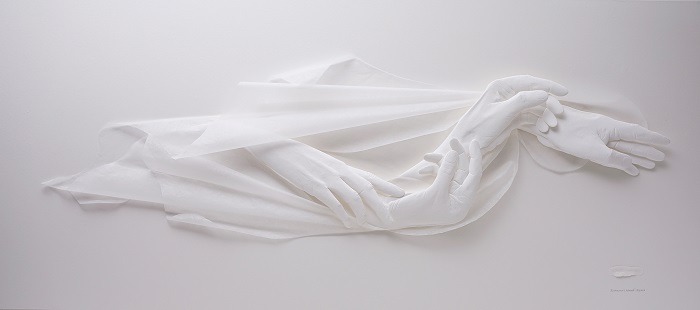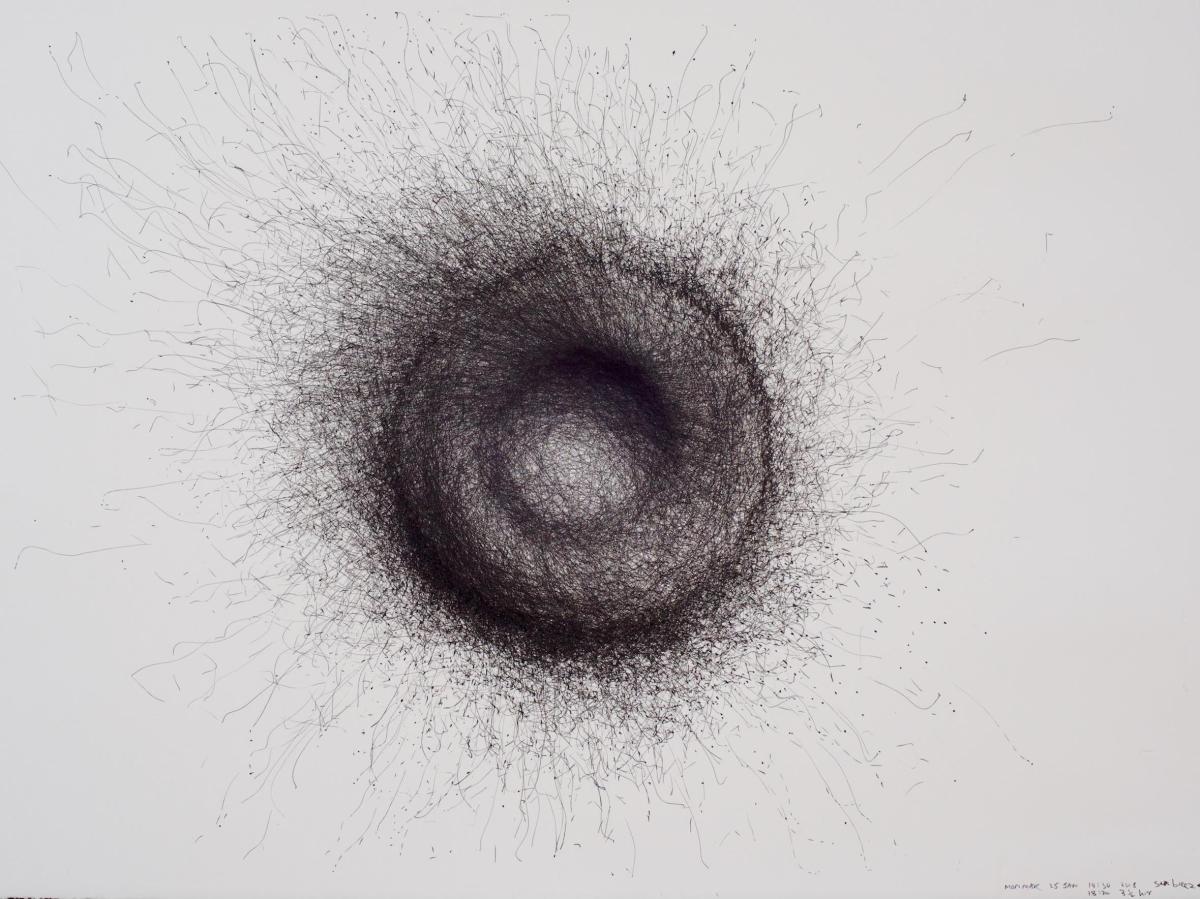Cameron Robbins, Monmar 3 ½ hrs sea breeze jan 25 2018. Pigment ink pen on paper. 56.0 x 76.0. Courtesy MPRG.
They all have paper in common in some form or other, but the distinguishing quality of this biennial exhibition is the audacious ingenuity of the artists. Whether it’s an experiment in process, or a reinvention of form, or a combination of mediums and techniques in a single piece, every one of these works has something original to say, often in meticulous and painstaking detail.
Among the more conventional works is David Frazer‘s linocut Slow Boat, a large-scale vista that is monumental in detail. Pei Pei He’s updated Chinese scroll of pencil on rice-paper titled In the Crowd uses strokes like threads to weave a long, long street scene with a ghostly quality. Trent Walter’s screen print and offset lithograph, Island Island, inverts images and print to trace shifts in our cultural perceptions of Asia and the subcontinent. Susanna Castleden’s 1:1 Gangway is a massive frottage of a 15-metre cruise ship gangway that dominates a wall at the entrance to the exhibition. TextaQueen’s savagely satirical poster, Flame within the Frame, confronts the place of the marginalised in institutional art.

Jane Brown Black Ships, 2016, hand printed, fibre based gelatin silver print 34.0 x 130.0 cm. Courtesy MPRG.
The eleven First Nations works are uniformly compelling. Although composed in black ink on paper, Alec Baker’s Ngura (Country) shimmers in granular detail. Robert Fielding’s pigment print on paper Manta Miil-Miilpa is an ode to the sacred earth, with the text and decorative background made by piercing the paper with hot iron, in tribute to traditional techniques. Hubert Pareroultja’s Namatjira-style Lukaria (West MacDonnell Ranges, NT) plays with perspective in the round. Composed with tea, ink and oil pastel and framed with kulata (spears), Tjukurpa Kunpu Nyangatja by Mumu Mike Williams decries the sacrilege of mining traditional lands. Two linocuts, Solomon Booth’s Dhangal Urgnu Tadiak and David Bosun’s Kubilaw Ulakal, could be companion pieces, the former stark and striking in black and white, the latter luminous in a phosphorescence of blue, both depicting dugongs, and both artists practising out of Moa Island in the Torres Strait.

Ray Besserdin, Endeavour’s Hands, 2017. Sculptured Paper. (Sheet formed, not cast) 76 x 154 cm. Courtesy MPRG.
Using paper as a medium, the 3D pattern of Liz Shreeve’s triptych Out of Darkness is a progression of light and a question about enlightenment. In Helen Mueller’s Deficit, 98 cast linocut prints paper bowls are symbols of a depleted environment. Tianli Zu’s papercut, Nüwa is Pregnant III, is a triumph of techniques learnt from Shaanxi peasants. Emily Sandrussi’s blank and pulped pages of a single volume of the Encyclopaedia Britannica, Arctic Biosphere [Volume 14], renders the notion of fixed knowledge as a frozen wasteland. The most sculptural is Ray Besserdin’s Endeavour’s Hands, a paean to liquid strength on 8 gsm hand-made translucent Japanese tissue.
In the pieces that experiment with process, Cameron Robbins invented an instrument using rotary mechanisms to create a wind-powered drawing in his Monmar 3 ½ hrs sea breeze jan 25 2018. Locust Jones uses almost an action painting style for his large-scale scrolls that serve as reels of film recording his spontaneous reactions to real-time media in Back to the dark ages II. Making books and newspapers become an exercise in intimacy for Deanna Hitti in TOWLA and Alana Hunt in Cups of nun chai respectively. Bianca Hester, Terri Bird and Scott Mitchell are Open Spatial Workshop, a collective that tests geophysical processes with human activities, such as the collision of charcoal on pink paper in Blind tactics.

James Tylor and Laura Wills, The Forgotten Wars, 2017, coloured pencil on photographic print 5 sheets, 50.0 x 50.0 cm (each image). Courtesy MPRG.
Out of a thousand initial entries to 2018 National Works on Paper, the finalists were reduced to these 63, and of them the winner came from the group that experimented with photography. The judges, MPRG Director Jane Alexander, Director of the TarraWarra Museum of Art, Victoria Lynn, and Curator of Academic Programs [Research] at the Ian Potter Museum of Art, University of Melbourne, Dr Kyla McFarlane, awarded the $15,000 acquisitive prize to James Tylor and Laura Wills for The Forgotten Wars, a series of five sheets of coloured pencil on photographic print that record seemingly quiet and unexceptional landscapes that have a horrific history and carry a colonial legacy of conflict, dispossession and massacre.
Almost without exception, the works on the walls and floor of MPRG are testament to the talent and grit and intelligence of artists across the continent. The efforts are theirs, the rewards are ours. See them and seize them in your imagination and memory.
4 ½ stars ★★★★☆
National Works on Paper Prize Exhibition 2018
Curator: Danny Lacy
20 July – 9 September, 2018
Mornington Peninsula Regional Gallery, Mornington





